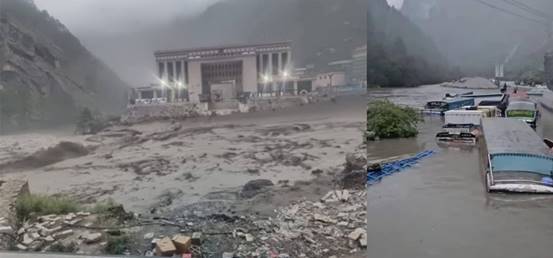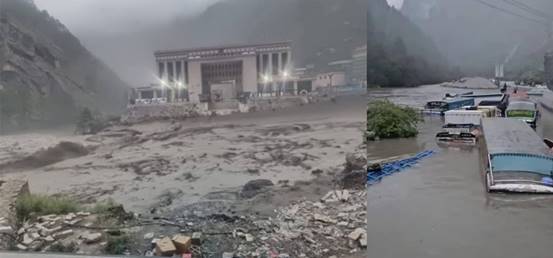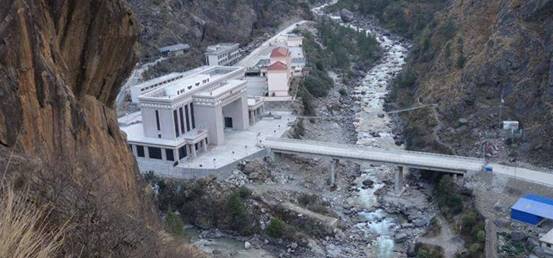按:德赛节(Dashain)是尼泊尔最重要的节日。2025年德赛节从9月22日开始至10月6日结束,尼历为2082年6月阿什温月6日-20日(Ashwin6-20,2082)。提哈节(Tihar)为尼泊尔灯节。2025年提哈节从10月19日开始至10月23日结束,尼历为2082年7月迦提月2日至6日(Kartik 2-6,2082)。
7月8日凌晨5时45分许,西藏吉隆县境内东林藏布河河水暴涨,吉隆口岸热索桥(友谊桥)被冲毁。尼泊尔为德赛节和提哈节进口的大批中国商品受阻。应尼方请求,中国方面正加紧援建贝雷桥替代被冲毁的热索桥(友谊桥),抢修道路设施,力争在十日内恢复通关。
中尼抢修吉隆-热索瓦口岸水毁设施,力争十日内恢复通关
来源:《共和国报》网站
https://myrepublica.nagariknetwork.com/news/rasuwagadhi-border-repairs-progress-as-china-begins-draining-blocked-kerung-73-45.html

加德满都7月13日讯(《共和报》报道):上周(7月8日)突发山洪导致尼泊尔第六大贸易通道——吉隆-热索瓦口岸中断后,修复工作正加速推进。据地方官员及贸易代表透露,中尼两国正全力抢修,争取10日内恢复跨境贸易。
此次灾害源于7月8日伦德河(Lhende River,即东林藏布)突发洪水,在吉隆河(Kerung River,即吉隆藏布)交汇处形成堰塞。当地武装警察部队证实,洪水裹挟巨型砾石、树干及杂物阻塞河道,致使中方一侧严重积水。目前中方已调集重型机械清障泄洪。
据边境安全官员称,洪水淹没了30多个中国货运集装箱,其中许多集装箱刚刚完成对尼泊尔的货物交付,正在等待返程。洪水还对附近的公路基础设施造成了严重破坏,导致双边货物运输停滞。
热索瓦海关(Rasuwa Customs Office)通报称,在尼泊尔一侧,热索瓦加蒂通道约1.2公里的路段有10多处受损。洪水冲走了24个尼泊尔集装箱、70辆已通关但尚未发货的电动汽车,以及几家中国物流公司的几辆大型卡车。由于司机短缺,这些车辆大多停在陆港或路边。
据海关办公室称,受损货物包括为德赛节进口的商品,如成衣、鞋类材料、食品和电子产品。他还表示,已通关的车辆和价值数百万的货物丢失或受到严重影响。洪灾还造成20人失踪(含3名尼泊尔警察、6名中国公民及多名司机和工人)。由尼泊尔陆军、武装警察部队和尼泊尔警察组成的搜救队仍在该地区展开行动。
驻在热索瓦加蒂的中国高级技术人员也报告称,洪水冲毁了负责陆港建设的西藏富利建筑公司的多辆施工车辆和设备。其中包括一台水泥搅拌机、一台压路机、一辆自卸车和一台挖掘机。
戈赛昆达农村自治市(Gosainkunda Rural Municipality)居民呼吁政府加快救援物资分发,确保滞留吉隆的尼泊尔公民安全返乡。
贸易专家表示,此次中断造成的经济影响重大。海关数据显示,本财年前11个月经该口岸进口额超800亿卢比(占总额4%),德赛节与提哈节前夕贸易量通常激增。
据中方通报,友谊桥(Miteri Bridge)及道路修复有望十日内完成,尼方道路修复近尾声。热索瓦的当地企业主也表示,尼泊尔一侧的道路修复工作已接近尾声,这增加了人们对该贸易路线将及时重新开放以满足季节性进口需求的信心。
为德赛节和提哈节进口的商品的受损,引发了人们对即将到来的节日期间可能出现短缺和价格上涨的担忧。专家建议通过北部替代贸易走廊临时分流进口货物——例如经塔托帕尼-樟木口岸与科拉拉-里孜口岸转运——以缓解供应链中断的冲击。
从更宏观的背景来看,海关部门的数据显示,尼泊尔本财年前11个月自中国进口总额达3140亿尼泊尔卢比,其中近半数(超1500亿尼泊尔卢比)经由热索瓦等北部陆路口岸入境。
原文:
Rasuwagadhi border repairs progress as China begins draining blocked Kerung river
https://myrepublica.nagariknetwork.com/news/rasuwagadhi-border-repairs-progress-as-china-begins-draining-blocked-kerung-73-45.html
Both Nepali and Chinese authorities are working to resume cross-border operations within ten days, according to local officials and trade representatives.

File Photo
By REPUBLICA
July 14, 2025 at 11:00 AM
KATHMANDU, July 13: Efforts to restore Nepal’s sixth-largest trading checkpoint i.e the Rasuwagadhi–Kerung border point, have intensified following last week's devastating flash floods. Both Nepali and Chinese authorities are working to resume cross-border operations within ten days, according to local officials and trade representatives.
The disruption was caused by a sudden flood in the Lhende River on July 8, which led to a blockage of the Kerung River near its confluence. According to the Armed Police Force (APF) stationed in the area, the flood carried large boulders, tree trunks and debris that obstructed the river’s flow, resulting in significant water accumulation on the Chinese side. In response, Chinese authorities have deployed heavy machinery to clear the obstruction and gradually release the impounded water.
According to border security officials, the flood submerged more than 30 Chinese cargo containers, many of which had just completed deliveries to Nepal and were awaiting re-entry. The floodwaters also caused considerable damage to the nearby highway infrastructure, halting the movement of goods on both sides.
The Rasuwa Customs Office reports that on the Nepali side, roughly 1.2 kilometers of the Rasuwagadhi access road were damaged at over 10 different locations. The flood swept away 24 Nepali containers, 70 electric cars cleared for customs but not yet dispatched, and several large trucks from Chinese logistics firms. Most of these vehicles were parked at the dry port or roadside due to a shortage of drivers.

According to the Rasuwa Customs Office, the damaged goods included Dashain-targeted imports such as ready-made garments, footwear materials, food products, and electronics. He also stated that customs-cleared vehicles and consignments worth millions were lost or severely affected.
Likewise, 20 individuals—including three Nepal Police personnel, six Chinese nationals, and several Nepali drivers and laborers were reportedly swept away during the flood. Search and rescue teams, consisting of Nepali Army, Armed Police Force, and Nepal Police personnel, remain deployed in the area.
Senior Chinese technical staff stationed at Rasuwagadhi have also reported that floodwaters destroyed several construction vehicles and equipment belonging to the Tibet-based Fuli Construction Company, which was engaged in dry port development. This includes a cement mixer, roller, tipper, and excavator.
Locals from the Gosainkunda Rural Municipality area, including elected ward officials, have urged the federal government to expedite relief distribution and ensure the safe return of Nepali nationals stranded in Kerung during the flood.
Trade experts say the economic impact of the disruption is significant. According to the Department of Customs, Nepal imported goods worth over Rs 80 billion through the Rasuwagadhi checkpoint in the first 11 months of the current fiscal year. While this accounts for about 4 percent of total imports, the volume typically increases in the months leading up to major festivals such as Dashain and Tihar.
Experts said that as per updates from Chinese logistics counterparts, repairs on the Miteri Bridge and road infrastructure are likely to be completed within ten days. Local business owners in Rasuwa have also indicated that road restoration on the Nepali side is nearing completion, increasing confidence that the trade route will reopen in time for seasonal imports.
Nonetheless, the damage to pre-imported goods has sparked concerns over potential shortages and price hikes during the upcoming festive season. Shrestha also suggested temporarily rerouting imports via alternate northern trade corridors such as Tatopani and Korala to mitigate the disruption’s effects.
In the broader context, data from the Department of Customs shows that Nepal imported goods worth Rs 314 billion from China in the first 11 months of the fiscal year, with nearly half—over Rs 150 billion—brought in through northern land ports like Rasuwagadhi.